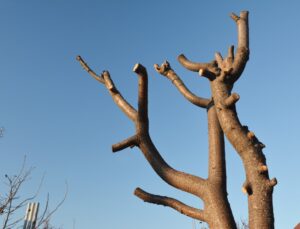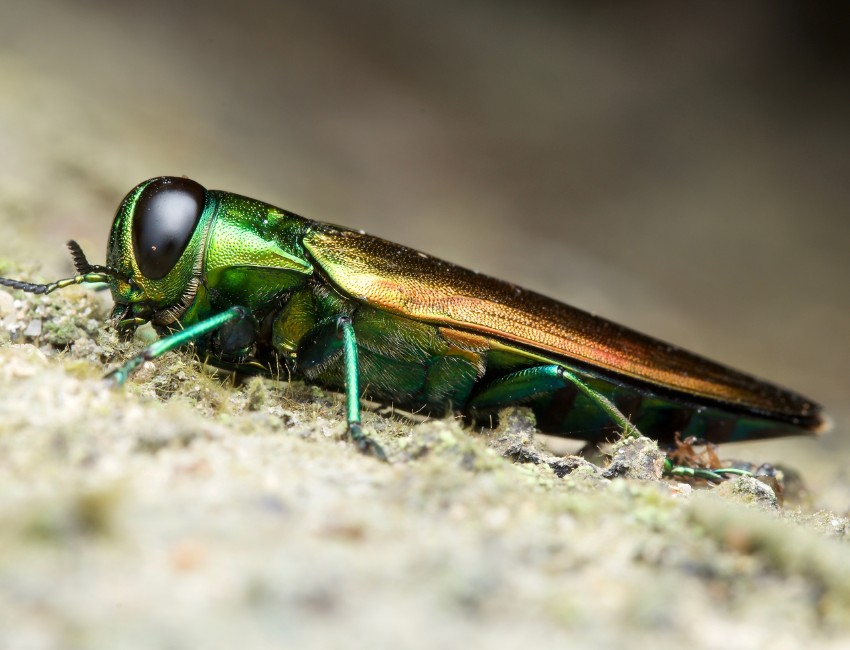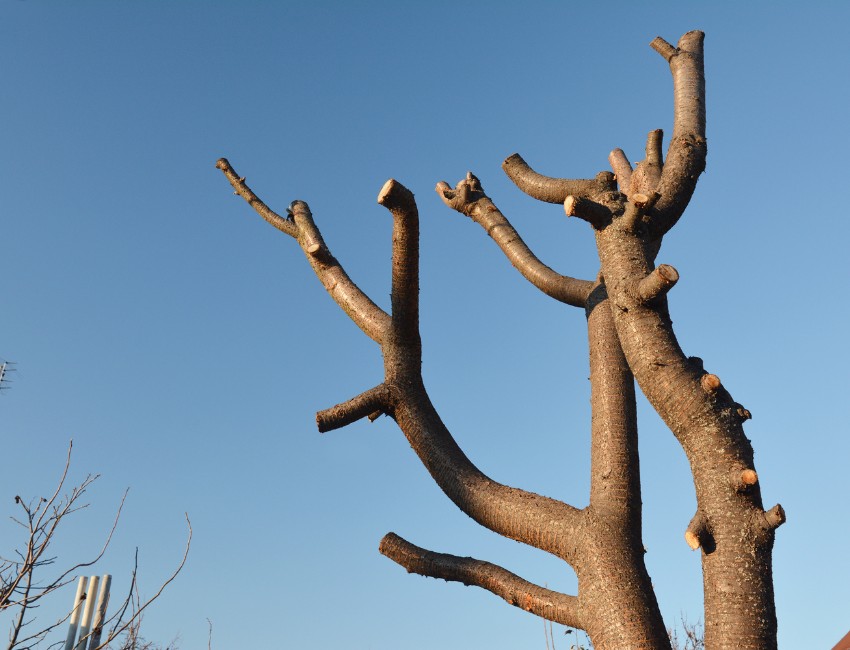Signs of Threatening Tree Diseases to Watch Out for in Portland

Have you spotted wilting leaves, bare branches, or strange spots on your trees? It might not just be stress – it could be a sign of disease. In Portland, common tree diseases can spread quickly and quietly, putting your trees (and even nearby ones) at risk. Learn more about the common symptoms of tree diseases in Portland and what to do when you spot them.
Key Takeaways:
- Common signs of tree disease in Portland include wilting leaves, discolored foliage, mold development, trunk damage, fungal growth, dead branches, and leaning.
- Diseases like Verticillium wilt, Dutch elm disease, anthracnose, and powdery mildew are common threats to Portland trees that require prompt attention.
- Regular inspections are essential for the early detection of disease symptoms, allowing for faster treatment and better chances of saving affected trees.
- When you notice signs of a tree disease, the best action is to call a professional arborist who can provide an accurate diagnosis and develop a specialized treatment plan.
- Not all diseased trees require removal, as an arborist may be able to treat some infections if you catch them early.
7 Common Signs of Diseased Trees
Though our trees face threats from numerous diseases, there are ways to protect them. One of the simplest things you can do to ensure they are healthy is to conduct regular inspections and look for any signs of disease.
“Diseases will manifest themselves in different ways, depending on the type of disease and the symptoms they produce. But there are some common signs you can watch for that indicate you’ve got a problem. So, while you may not be able to tell exactly what’s wrong with your tree, you will at least know you have to take action to try and help it recover.” – Alex Hoekstra, ISA Certified Arborist ArborPro
1. Wilting Leaves
If you notice that a tree’s leaves have begun to wilt, it is a sign that something is wrong. However, identifying the exact problem when you see wilting is difficult, as the symptom could point to several possible issues, such as:
- Heat stress
- Drought stress
- Poor soil drainage
Wilted leaves can also point to diseases that cause problems with the tree’s ability to transport water. Two of the primary reasons your trees may have wilting leaves are Verticillium wilt and Dutch elm disease. Both of these diseases are deadly and require fast action to either try and save the tree or prevent the disease from spreading to nearby species.
2. Discolored or Blemished Foliage
A few discolored or damaged leaves in your canopy are likely nothing to worry about. A substantial amount of yellow or brown leaves on your tree is likely a sign of a disease.
Damaged leaves could indicate an attack from insects feeding on them or a disease. Anthracnose, Coryneum blight, and Verticillium wilt cause leaves to turn brown in the summer before showing fall colors.

3. Mold or Fuzzy Growth
Mold isn’t just a problem in your bathroom; it can affect your trees as well. Look for signs of white powder or mold developing in the canopy. While these problems are often not life-threatening, they can harm your tree’s aesthetics and reduce its ability to perform photosynthesis.
The two most common causes of mold or fuzz development in your Portland trees are powdery mildew and black sooty mold caused by aphid feeding.
Regular tree pruning to reduce canopy density will lower the risk of mold and mildew forming. Cleaning the canopy allows more sunlight to penetrate and air to get through, reducing the risk of developing humid conditions that lead to mold.
4. Cankers or Bark Damage
Some tree diseases produce cankers on branches or the trunk. Cankers are typically small and display color, especially after it rains. Anthracnose is the most common cause of cankers on Portland trees, and its symptoms are worse when we have cooler, wetter weather.
If you have black walnuts on your property, keep an eye out for thousand cankers disease. Beetles feeding on the bark will spread the disease and can rapidly kill your walnut trees.
5. Fungal Growth at the Base
Mushrooms growing on the base of your tree may add some interesting aesthetic appeal to it, but they are also a sign of something deadly happening under the surface. Mushrooms often indicate problems like root rot or a fungal disease in the trunk.
6. Dead or Dropping Branches
Diseases can infect trees and potentially kill branches or cause them to drop off. If you look up at your tree and notice a lack of greenery in spots, it could indicate it has a disease infection.
Don’t jump to conclusions when you see dead branches, as there are several factors that could have caused it, including:
- Lack of water
- Too much heat and humidity
- Insect attacks
7. Leaning Tree
In normal conditions, a tree should stand nearly vertical, with only a slight natural lean. When a tree begins leaning more noticeably, it’s often a sign of underlying issues such as improper planting, soil erosion, internal decay, disease, or root rot.
Leaning trees are more vulnerable to falling – especially during storms or high winds – which puts people and property at risk. That’s why it’s important to have an ISA Certified Arborist assess the tree as soon as possible.
One red flag to watch for is mushrooms growing near the base of the tree. This can indicate advanced decay in the roots or lower trunk, making the tree even more unstable. If you notice both a lean and fungal growth, prompt evaluation and action are important.

Tree pruning can remove diseased material from trees and reduce the risk of mold and fungus developing in the canopy.
What to Do When You Notice Signs of Tree Disease
If you see any of these symptoms in your trees, it’s important not to panic. While they may indicate something is wrong, there may still be time to save your trees from whatever is ailing them, but only if you work with an arborist. Call an arborist and have them inspect your trees for disease. They’ll get you an accurate diagnosis and create a specialized care plan based on the severity of the infection, the condition of the tree, and the probability of saving it.
Some of the recommendations your arborist may have include:
- Fungicide injection
- Tree pruning to remove dead or diseased limbs
- Removing a tree when the disease is too severe or the tree is dead
Frequently Asked Questions About Tree Diseases in Portland
Tree diseases are some of the most complex problems we deal with in Portland. To help you better understand diseases and the damage they cause, we’ve answered common questions many homeowners in the Pacific Northwest have.
What are some of the most common tree diseases in Portland?
Some of the most common diseases we face in Portland include:
- Anthracnose
- Dutch elm disease
- Verticillium wilt
- Thousand cankers disease
- Powdery mildew
Can I treat tree diseases myself?
Generally speaking, trying to treat tree diseases yourself will be less effective than allowing an arborist to handle the job. Arborists have years of experience treating trees and access to tools and chemicals that a homeowner doesn’t. Let a professional handle the job if you want the best chance at saving your trees.
Will all trees with a disease end up needing to be removed?
No, not necessarily. Many tree diseases are manageable – especially when caught early. Some conditions may only affect part of the tree or cause cosmetic issues without threatening its overall health. In many cases, prompt treatment and proper care can stop the disease from spreading and help the tree recover. That’s why it’s so important to take action as soon as you notice signs of trouble.

ArborPro Can Help Treat and Protect Your Trees from Common Diseases
When something doesn’t look right with your tree, don’t ignore it – early signs of disease can escalate quickly. Tree health issues are often complex, and proper diagnosis and treatment require professional expertise. This isn’t a job for just anyone – you need an experienced, ISA Certified Arborist.
The team at ArborPro Tree Experts has experience caring for and saving Portland trees from the various diseases that affect them. We can examine your trees, provide treatment, and give you recommendations for future care. Call us today at 503-473-8733 for help with your sick species, or request a quote online.








